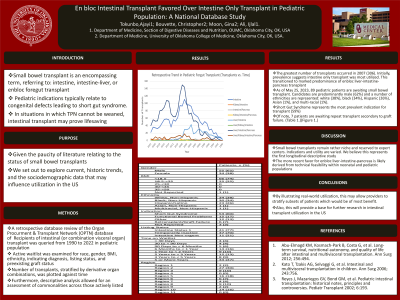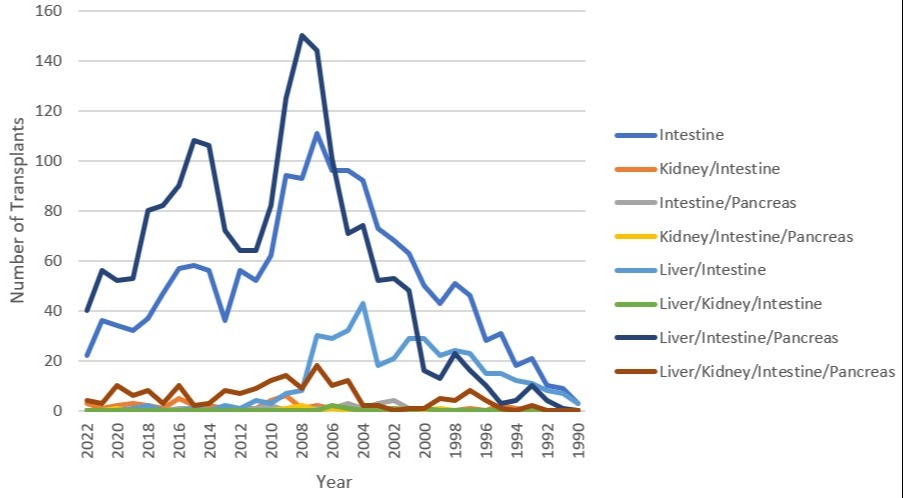Tuesday Poster Session
Category: Small Intestine
P4111 - En bloc Intestinal Transplant Favored Over Intestine Only Transplant in Pediatric Population: A National Database Study
Tuesday, October 24, 2023
10:30 AM - 4:00 PM PT
Location: Exhibit Hall

Has Audio
- TA
Tokunbo Ajayi, MD
University of Oklahoma College of Medicine
Oklahoma City, OK
Presenting Author(s)
Tokunbo Ajayi, MD1, Christopher Bouvette, MD2, Gina Moon, MD3, Ijlal A. Ali, MD1
1University of Oklahoma College of Medicine, Oklahoma City, OK; 2University of Oklahoma Health Sciences Center, Oklahoma City, OK; 3Oklahoma University Health Sciences Center, Oklahoma City, OK
Introduction: Small bowel transplant is an encompassing term, referring to: intestine, intestine-liver, or enbloc foregut transplant. Pediatric indications typically relate to congenital defects leading to short gut syndrome. In situations in which TPN cannot be weaned, intestinal transplant may prove lifesaving. Given the paucity of literature relating to the status of small bowel transplants, we set out to explore current, historic trends, and the sociodemographic data that may influence utilization in the US.
Methods: This was a retrospective database review of the Organ Procurment & Transplant Network (OPTN) database. Receipt of intestinal (or combination visceral organ) transplant was queried by year for 1990 to 2022, and recipients were selected by age to define the pediatric population. Furthermore, the active waitlist was examined for variables of interest, to include race, gender, BMI, ethnicity, indicating diagnosis, listing status, and preexisting graft status. Number of transplants, stratified by derivative organ combinations, was plotted against time. Furthermore, descriptive analysis allowed for an assessment of commonalities across those actively listed.
Results: Reviewing historic prevalence, the greatest number of transplants occurred in 2007 (306). Initially, prevalence suggests intestine only transplant was most utilized. This transitioned to marked predominance of enbloc liver-intestine-pancreas transplant. As of May 25, 2023, 89 pediatric patients are awaiting small bowel transplant. Candidates are predominantly male (62%) and a number of ethnicities are represented: white (38%), black (34%), Hispanic (26%), Asian (1%), and multi-racial (1%). Short Gut Syndrome represents the most prevalent indication for transplant (59%). Of note, 7 patients are awaiting repeat transplant secondary to graft failure. (Table 1.)(Figure 1.)
Discussion: Small bowel transplants remain rather niche and reserved to expert centers. Indications and utility are varied. We believe this represents the first longitudinal description. The more recent favor for enbloc liver-intestine-pancreas is likely derived from technical feasibility within neonatal and pediatric populations. We hope to demonstrate historic trends in small bowel transplants. By illustrating real-world utilization, this may allow providers to stratify subsets of patients which would be of most benefit. Also, this will provide a base for further research in the area of intestinal transplant utilization in the US.

Disclosures:
Tokunbo Ajayi, MD1, Christopher Bouvette, MD2, Gina Moon, MD3, Ijlal A. Ali, MD1. P4111 - En bloc Intestinal Transplant Favored Over Intestine Only Transplant in Pediatric Population: A National Database Study, ACG 2023 Annual Scientific Meeting Abstracts. Vancouver, BC, Canada: American College of Gastroenterology.
1University of Oklahoma College of Medicine, Oklahoma City, OK; 2University of Oklahoma Health Sciences Center, Oklahoma City, OK; 3Oklahoma University Health Sciences Center, Oklahoma City, OK
Introduction: Small bowel transplant is an encompassing term, referring to: intestine, intestine-liver, or enbloc foregut transplant. Pediatric indications typically relate to congenital defects leading to short gut syndrome. In situations in which TPN cannot be weaned, intestinal transplant may prove lifesaving. Given the paucity of literature relating to the status of small bowel transplants, we set out to explore current, historic trends, and the sociodemographic data that may influence utilization in the US.
Methods: This was a retrospective database review of the Organ Procurment & Transplant Network (OPTN) database. Receipt of intestinal (or combination visceral organ) transplant was queried by year for 1990 to 2022, and recipients were selected by age to define the pediatric population. Furthermore, the active waitlist was examined for variables of interest, to include race, gender, BMI, ethnicity, indicating diagnosis, listing status, and preexisting graft status. Number of transplants, stratified by derivative organ combinations, was plotted against time. Furthermore, descriptive analysis allowed for an assessment of commonalities across those actively listed.
Results: Reviewing historic prevalence, the greatest number of transplants occurred in 2007 (306). Initially, prevalence suggests intestine only transplant was most utilized. This transitioned to marked predominance of enbloc liver-intestine-pancreas transplant. As of May 25, 2023, 89 pediatric patients are awaiting small bowel transplant. Candidates are predominantly male (62%) and a number of ethnicities are represented: white (38%), black (34%), Hispanic (26%), Asian (1%), and multi-racial (1%). Short Gut Syndrome represents the most prevalent indication for transplant (59%). Of note, 7 patients are awaiting repeat transplant secondary to graft failure. (Table 1.)(Figure 1.)
Discussion: Small bowel transplants remain rather niche and reserved to expert centers. Indications and utility are varied. We believe this represents the first longitudinal description. The more recent favor for enbloc liver-intestine-pancreas is likely derived from technical feasibility within neonatal and pediatric populations. We hope to demonstrate historic trends in small bowel transplants. By illustrating real-world utilization, this may allow providers to stratify subsets of patients which would be of most benefit. Also, this will provide a base for further research in the area of intestinal transplant utilization in the US.

Figure: Retrospective Trend in Pediatric Forgut Transplant (Transplants vs. Time)
Disclosures:
Tokunbo Ajayi indicated no relevant financial relationships.
Christopher Bouvette indicated no relevant financial relationships.
Gina Moon indicated no relevant financial relationships.
Ijlal Ali indicated no relevant financial relationships.
Tokunbo Ajayi, MD1, Christopher Bouvette, MD2, Gina Moon, MD3, Ijlal A. Ali, MD1. P4111 - En bloc Intestinal Transplant Favored Over Intestine Only Transplant in Pediatric Population: A National Database Study, ACG 2023 Annual Scientific Meeting Abstracts. Vancouver, BC, Canada: American College of Gastroenterology.
